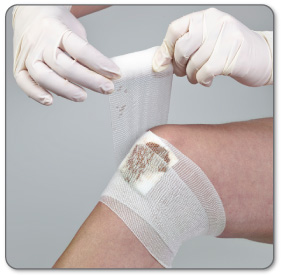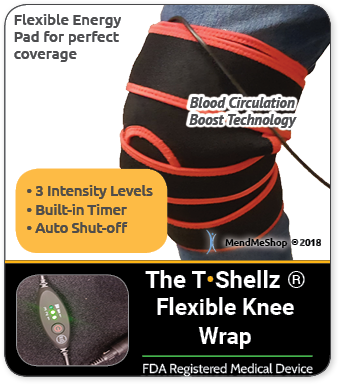|
| Posterior Horn Meniscus InjuryAnterior = Front, Posterior = BackLateralThe lateral meniscus is held in place at two points; one end - the anterior horn - attaches at the front of the knee to the tibia via the anterior cruciate ligament (ACL) . The other end - the posterior horn - attaches to the meniscofemoral ligament. Unlike the medial meniscus, the lateral meniscus does not rely on a collateral ligament to hold it in place - which is why the lateral meniscus is allowed to 'float' freely inside the small space of the knee joint. Removing the entire lateral meniscus can cause a knock-kneed deformity and lateral joint arthritis. MedialThe medial meniscus is held in place at three points. One point (at the anterior horn location) attaches at the front to the tibia via the anterior cruciate ligament (ACL) on the intercondylar area. The second point of attachment is at the posterior horn location where it attaches to the intercondylar area of the tibial plateau. The third and final attachment point is where the medial meniscus meets the medial collateral ligament (MCL). The MCL anchors the medial meniscus so it doesn't move as freely in the knee joint space as the lateral meniscus. This extra anchoring prevents the medial meniscus from moving as freely as the lateral meniscus which is a large reason why you are more likely to suffer from a medial meniscus tear than a lateral meniscus tear. Removing the entire medial meniscus can lead to a bow-legged deformity and medial joint arthritis Posterior Horn Meniscal TearsThe most common location for a meniscus tear is in the back of the knee and on the inner side of the knee. In medical terms this means that of the two meniscus in the knee (lateral vs medial), the medial meniscus is more likely to tear. Further to this, the tear is more likely to occur near the posterior horn - which is located at the back of the knee.2 You can suffer an injury to your medial meniscus or lateral meniscus due to a traumatic event or from degeneration of your meniscal tissues. There are many types of posterior meniscal tears you can suffer from but a tear at the location of the posterior horn is the most common place of injury. The pattern of the meniscal tear is also an important factor to determine whether you are able to heal without surgery. "Because the posterior horn of the medial meniscus absorbs most of the weight of the medial compartment, it is also by far the most frequent area that a meniscus tear occurs in. This is especially true in patients who have an ACL tear, where this portion of the meniscus then acts as the main structure to prevent the knee from slipping forward (anteriorly)."1 Complex Tear Posterior Horn Medial Meniscus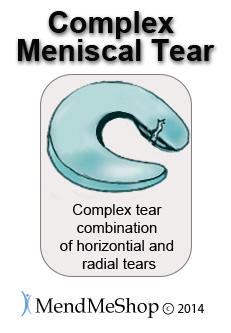 A complex tear of the posterior horn of the medial meniscus means that you have more than one tear pattern to your meniscus in the area of the posterior horn. Complex tears may be caused by:
Degeneration of the Medial Meniscus at the Posterior Horn As we age, it is natural that soft tissue in the body weakens and thins - this is just as true for the menisci in the knee as it is for muscles and tendons. If you are suffering from a degenerating meniscus, you will find that the meniscus thins and is more liable to fail (tear) when under load. You may have had a very active lifestyle in the past and/or even suffered a slight injury to your meniscus in your youth which has accelerated the deterioration of the meniscus. A deteriorating meniscus thins, wearing out with use over time; eventually, the edges start to fray. It is not uncommon to tear a degenerated meniscus easily - such as giving a slight twist to your knee while doing a simple activity such as stepping down from a chair, or even just stumbling forward while recovering your balance from a near fall. You will likely hear a "pop" sound, followed by swelling and stiffness increasing gradually over a few days after injury. Oblique Tear Posterior Horn Medial MeniscusOblique tears are vertical cleavage tears that start in the inside of the meniscus then travel diagonally outward - in some ways you could say that they are part radial tear and part longitudinal tear. Most oblique meniscus tears are happen in the posterior third of the medial meniscus. Oblique tears commonly cause flaps and flaps are generally not good. Flaps cause mechanical instability - meaning they interrupt the smooth function of the knee joint and will make your knee joint feel unstable. Flaps causes by oblique tears typically mean that either some or all of the meniscus need to be removed - usually through arthroscopic surgery. Surgeons will try not to fully remove a meniscus if possible - especially in a younger person as the removal of a meniscus leads to arthritis and often persistent knee pain. When faced with a complete meniscectomy, a physician or surgeon may advise a full knee replacement as a good option. Horizontal Cleavage Tear Posterior Horn Medial Meniscushorizontal tears = cleavage tears = fish mouth tearsA horizontal tear (also known as fish-mouth tears) at the posterior horn of the medial meniscus means that the meniscus has torn along the horizontal plane - a type of tear that can be difficult to see when looking at some MRI's. Fish-mouth tears are common in older people as degeneration may be present in the meniscal tissue. With a horizontal tear, the meniscus has been sliced in the middle, as if it were a bun cut into to pieces (superior and inferior flaps).  Radial Tear Posterior Horn Medial MeniscusA radial tear of the posterior horn of the medial meniscus; Traumatic events in young active people suffer from the injury to the posterior horn, along with a tear to the ACL. A vertical tear at the junction of the posterior and middle thirds of the meniscus has been damaged. More often the lateral meniscus has suffered the torn meniscal tissue then the medial. Longitudinal Tear of the Medial Meniscus Posterior HornA longitudinal tear of the posterior horn of the medial meniscus is common in older people as degeneration may be present in the meniscal tissue. With this type of tear, the meniscus has been sliced in the middle - as if it were a bagel bun cut into to pieces (superior and inferior flaps). This type of tear near the posterior horn is commonly associated with a chronic anterior cruciate ligament (ACL) deficiency, meaning you are more likely to suffer this type of tear if you have a weakened or torn ACL. Conversely, if you have this type of tear and your ACL is intact, you will be adding more stress to the ACL as many studies have demonstrated the importance of the medial meniscus in terms of limiting the amount of anterior-posterior tibial translation in response to anterior tibial loads in ACL-deficient knees.3 Posterior Horn Meniscal Tear SizeThe size of your meniscus tear will have some affect on your ability to heal the tear through conservative treatments. Meniscus tears under 1 cm can heal without surgery if it's located in the red-red or red-white zone (with some blood supply for healing). Tears that are 1.5 cm to 4 cm usually require surgery. The size of the tear becomes important because if the tear in the tissue is too large it will not heal without the help of your surgeon. To understand why the size of your tear is important, let's imagine you have 2 slices of bread in front of you. You tear one just a little (less than an inch) and place it down. When you do this the bread will naturally pull the edges of the small tear back together. You tear the 2nd slice of bread in half (or more). When you place the bread down it will be floppy, and remain out of shape. You would need your hands, some peanut butter, or something else to force/keep both sides of the tear together. Your meniscus is no different, small tears have the ability to heal and large tears need surgery to repair the tissue. What Causes A Posterior Horn Meniscus Tear?Anyone can injure their meniscus, though the meniscus is most often injured from sudden and traumatic accidents. This can happen from sudden changes in direction with the leg - like when your foot is fixed / planted on the ground and a twisting force is applied to your knee. It can also get injured with a combination of excessive straightening or bending of the knee which is what happens in a forceful jump or landing, and / or direct side impact to the knee joint. A tear of the posterior horn of the meniscus can be caused in many ways. One of the most common causes, however, is when your tear your ACL. If you are undergoing a movement where the ACL tears and the knee continues sliding forward - it could and often does tears the posterior horn of the medial meniscus. Bending your knee(s) very deeply (known as "deep knee flexion") - especially under high load such as you would imagine in weightlifting - also places significant stress on the posterior horn of the meniscus; this can result in a posterior horn meniscus radial tear, peripheral tear, or root tear. 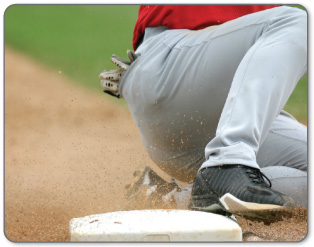 Athletes that play sports where their knee is bent have an increased risk of getting a posterior horn meniscus injury. This includes athletes who participate in sports like volleyball, football, soccer, tennis, basketball, an incorrect slide into base in baseball, hockey, weight lifters and racket sports. Young athletes are more likely to suffer a posterior horn meniscus tear along with an anterior cruciate ligament (ACL) injury.  Everyone can be affected by degeneration of their meniscus over time, edges of the meniscus become frayed, jagged, and thin. Any repetitive or frequent movement can place stress on your meniscus over the years. The knee joint itself suffers degenerative changes such as arthritis, osteoarthritis and/or cartilage thinning on the ends of the bones. This gradual wear and tear on the knees comes for overuse, repetitive knee movements, twisting or prolonged weight bearing activities. Degenerative changes to the knee happen slowly, so you may suffer a torn meniscus from a simple daily activity. Since we know that the medial meniscus handles a lot of the load at the posterior horn, as one ages, degenerative tears of the posterior horn of the medial meniscus can occur due to these wear and tear changes. Symptoms of a Posterior Horn Meniscus TearYou might be suffering from a torn posterior horn of the meniscus if: 
If you've suffered a traumatic sudden injury to your knee while playing sports, swelling to your knee will happen within a few hours after the injury or in the following days. You may also experience more intense pain when bending, walking, or twisting your knee. You will most likely continue to feel a buildup of pain tenderness in the knee over the next couple of days.  This feeling may be combined with locking, catching or clicking in your knee. There is usually pain with weight bearing activity such as climbing stairs and twisting movements of the knee when kneeling or squatting. Degenerative Posterior Horn meniscus tears are subtle with pain that increases over time. You may also notice swelling after exercise or daily activities. If you do have pain, you'll experience pain on the outer side of your knee and possibly feel weakness / instability in your knee with locking, catching or clicking. Pain may increase with certain activities, like climbing a set of stairs, kneeling to do the simplest thing as putting away your groceries or squatting to pick up something you may have dropped.  If you're suffering from a chronic Posterior Horn meniscus injury you may have developed a limp due to severe pain or you're unable to stand for long periods of time. A chronic injury could also result in a 'buckling' of your knee when weight is placed on it and loss of range of motion. If you are suffering from a Lateral Meniscus Tear at the Posterior Horn, cysts are more like to develop in the knee. This 'cyst' decreases your range of movement potentially leaving you unable to stretch out your knee. You may experience tightness because of swelling and tenderness around your knee. A Posterior Horn of the lateral meniscus injury left untreated, will have increased inflammation. The lateral meniscus becomes less 'mobile' during flexing, extension and rotation movements of the knee. Increasing the likelihood of having a second meniscus injury such as a bucket-handle tear (longitudinal) or transverse tearing. How Do I Diagnose a Posterior Horn Meniscus Tear? The best way to diagnose this condition is with a quick visit to the your doctor for a physical examination of your knee. As we say elsewhere, there are many conditions other than meniscus injuries that can cause knee pain such as an ACL tear, patellar or quadriceps tendinitis, a fracture, arthritis or knee bursitis. Getting a proper diagnosis is important so you can treat your condition correctly. It is generally more difficult to diagnose a Posterior Horn meniscus tear - usually due to its tear shape and location. Know that it is not uncommon for a lateral meniscus tear may go unnoticed until it becomes much larger. Your doctor will gather a medical history about you, including taking into consideration previous knee injuries or joint stiffness that you have had in the past. This will help the doctor to determine if you have a more complex injury in your knee and rule out any other knee injuries that may be present. Range of motion tests will be done to see how much movement has been lost in the knee. Typical range of motion tests for the knee include the McMurray's Test, joint line tenderness and the Ege's test. Your knee might hurt from the doctor poking and prodding at it, but by doing this the doctor will know for sure the source of your pain, the level of tenderness in and around your knee and how well your knee can move with this condition.  Your doctor may suggest diagnostic testing to obtain more detailed information, and assess the amount and/or type of damage done to your knee and meniscus. There are a variety of different tests available to help them analyze the situation; and the recommendation will be dependent on your injury. X-rays will provide an image of the overall bone structure of your knee. It's helpful in identifying abnormal bone shapes, fractures, arthritis, or loose bones and bone abnormalities that may mimic a torn meniscus. Other tests like a bone scan, MRI (magnetic resonance imaging) or blood tests may be done if an x-ray looks normal or the doctor is unsure whether you have a fracture. These tests will also rule out any infections of the bone or tissue and help to determine if you are suffering from other injuries like arthritis or osteoarthritis (degenerative damage). If you are experiencing a build up of fluid in the knee, your doctor may aspirate (use a needle) to remove fluid from the joint to check for bacterial infection. Your doctor will be able to determine whether there is an infection or not by drawing a small sample of the synovial fluid with a needle. If it is determined that there is an infection, you will be prescribed antibiotics to get rid of the infection and the physician may pursue deeper inspections into determining the source o infection. If you suspect you may have a Posterior Horn meniscus tear...
After Diagnosis...Once your doctor has given you the news about your meniscus injury he/she will immediately start you off with proactive conservative treatments - even before you have a full MRI diagnosis. This is because your doctor wants to arrest the meniscus damage, decrease swelling and get you on the path toward healing. Depending on severity and location meniscus injuries can heal through conservative treatment options - not every torn meniscus requires surgery! Some conservative treatment methods recommended include:
'Over Compensation Pain': A Big Issue With Meniscal Tears (and Other Painful Knee Injuries)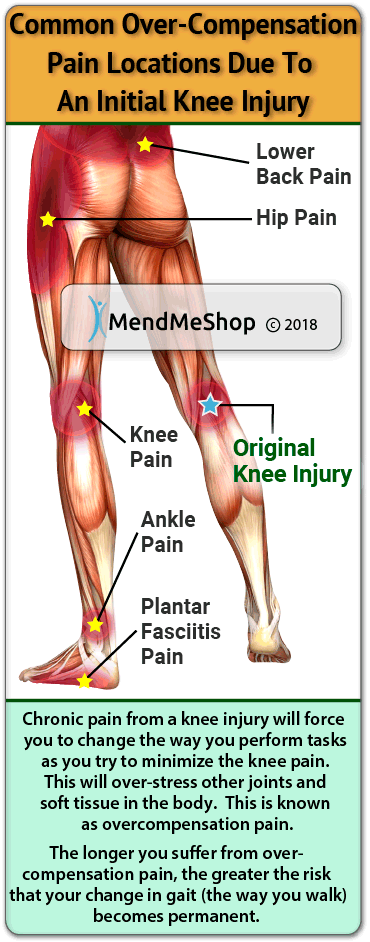 Since you are reading this, you probably know that serious knee injuries do not just disappear. Over time, it will wreak havoc on your knees, hips, ankles and lower back due to lack of movement, over-compensation and a change in gait. It will also wreak havoc on your opposite knee, due to the fact that you will be overusing it to compensate for not using the bad knee. Recovery takes a longer time for such chronic (long term) injuries, but proper healing is essential to regain strength and get you back to the activities you enjoy. Everything in the human body is connected. Any meniscus injury can lead to other injuries over time if not treated properly. You WILL subconsciously start shifting more of your weight onto your opposite leg when performing normal daily activities, like climbing the stairs or when standing for long periods of time. You may also try to limp using your opposite (healthy / stronger) leg to get back to work, activities or your sports sooner to avoid waiting for your medial meniscus injury to heal completely. Many of our clients have experienced pain in their opposite foot, ankle, knee and hip because they shift their standing weight to the opposite side of their body. For example, you might normally climb stairs by leading with your injured knee, but instead will lead with your opposite leg and hop or shuffle more than walk the stairs. Even though changing something like this seems like a really small thing, changing the way you would normally climb a set of stairs when your body isn't used to that can result in pain and injuries in your healthy knee and leg. The longer your injury endures, the greater the risk of running into serious overcompensation injuries and a permanent change in gait.Over time you'll notice that you automatically start to put more weight on your non-injured side to cope with everyday activities. When you experience pain in other areas of the body due to minimizing the pain from an older injury, this is something called "over compensation" pain. Usually degenerative medial meniscus pain will happen to your dominant knee (if you are right handed, this would be your right knee). When this happens there is a higher risk that you'll over-strain your weaker knee that's compensating for your injury, because it's just not as strong as your dominant side. Circulation Boost (Circulatory Boost) is the best treatment available to deal with over compensation issues and injury prevention by maintaining healthy blood flow in around your injured meniscus AND in your healthy knee as well. If you are also experiencing overcompensation pain in the hips, we recommend the use of a BACK/HIP TShellz Wrap® Even if you try to avoid over compensation pain in your healthy knee, you're still at risk for re-injuring your damaged meniscus. Ignoring over compensation pain and the pain felt from your meniscus injury while returning to regular activities or your job can and usually will lead to even more problems with healing. To Stop A Worsening Meniscus Tear & Reduce the Risk of a More Serious Overcompensation Injury, You Need to Heal Quickly & Completely!Time is unkind to an immobilized joint - you lose strength in your knee but worse than that, you lose the range of motion from atrophy (your flexible tendons, muscles and ligaments slowly shrink / waste away, decreasing joint elasticity). The more time that goes by with your knee immobilized, the more likely you'll wind up with a worsening meniscus tear or perhaps a secondary chronic (long term) problem stemming from reduced range of motion and/or immobility. Basically it means that your knee won't perform as well as it once did and becomes more prone to injury again later on. If you have a torn meniscus in your knee, it's very important to heal it quickly and completely. Minimizing the healing time of your medial meniscus should be an obvious goal, as meniscus tears will no doubt limit your ability to go about your daily routine; but also keep in mind that untreated meniscus tears will typically get worse over time. As stated in pennmedicine.org (2018), "If not treated, part of the meniscus may come loose and slip into the joint. You may need surgery to restore full knee function. Untreated meniscus tears can increase in size and lead to complications, such as arthritis." Dealing with a continuously worsening meniscus tear, chronic inflammation / swelling, loss of range of motion and an increasing risk of overcompensation injuries mean you'll have a greater chance of winding up with a chronic knee condition or a serious case that needs to be resolved with surgery. This is why it's so important to continuously use conservative treatment tools to treat and heal recurring soft tissue damage before it builds into something bigger. For anyone that is suffering from a torn meniscus, having the right tools makes all the difference. The Good News: the Body uses Blood to Repair ItselfBefore we go further, it's important to understand that your body is capable of healing itself. This is why your doctor will always try to opt for the conservative treatment first - usually, it works although it takes time to heal. Your blood flow carries oxygen and much needed nutrients to injured tissue in the body while also flushing away toxins and waste at the same time. When you have a posterior Horn meniscus injury, however, there is not much blood flow available in your injured meniscus, especially if your tear is in the White zone. Inflammation and reduced movement (lack of activity or on-going immobility) reduces the flow of blood to an area that's already receiving very little blood flow. If you're moving your injured meniscus around you run a risk of increasing the severity of the injury. If there has been some healing, you could re-injure your meniscus all over again. Blood Flow - the natural healing process in your body - needs assistance for meniscus injuries because blood flow is greatly reduced when you're injured. When treating a meniscus injury or really any type of meniscus or knee injury (ie. Lateral meniscus tear, bucket-handle tear, posterior horn tear, or anterior horn tear), you need to increase blood flow to your injury while your knee is healing. This increase in blood flow will accelerate your body's own ability to heal itself. In our opinion, the Knee TShellz Wrap® is the most highly effective blood flow stimulation device that you will find available for home use on the market. To Start Recovery, Healing Time must be Minimized with Effective Treatment OptionsIf you have a meniscus injury, it's very important to heal it quickly and completely. Minimizing the healing time should be an obvious goal, as a chronic Posterior Horn meniscus tear will limit your ability to go about your daily routine for a long period of time. A seemingly small, nagging injury in your meniscus that's not properly treated can lead to a chronic painful degenerative Posterior Horn meniscus tear that can persist for months or even years if not properly treated. Meniscus surgery is the most commonly performed orthopedic surgery in the United States1 and the posterior horn is the most common area for degenerative tears of the meniscus. One major reason for this is that the meniscus is very important; knowing the heavy correlation between meniscus deficiency and osteoarthritis, doctors are doing everything they can to try and repair a meniscus instead of removing it. Doctors and surgeons know that meniscus surgery will introduce more scar tissue into the knee - this is why they only recommend surgery as a last resort. This added scar tissue will be problematic, requiring physical therapy and conservative treatment options post-surgery. If you receive good news from your doctor, he or she will predict that your meniscus can be successfully healed through the use of conservative treatment therapies - without resorting to knee surgery. If you have been given news that you're going to need surgery, once surgery is complete your doctor will once again start you on home conservative therapies. Talk to your doctor about when you can incorporating the Knee TShellz Wrap® into your home treatment plan during your post surgery recovery. Posterior Meniscus Tear Home Conservative Treatment OptionsStep 1 - Reduce Pain and Swelling with Cold CompressionThe first step for conservative treatment of a meniscus tear is to reduce the swelling in the knee to "open up" the area for more blood flow. Anyone in the health-care business knows that your blood supplies the oxygen and much needed nutrients required to heal soft tissue tears. This is why for years, doctors, trainers, and other medical professionals have recommended RICE (Rest, Ice, Compression, Elevation) to treat the pain and swelling of fresh injuries, chronic pain, re-injuries and overcompensation strains. This is important because once blood vessels are blocked or damaged, they can no longer carry oxygenated blood to your damaged tissue so this tissue begins to break-down. Without cold therapytissue damage and break-down continue as they cannot get the oxygen they need to survive By limiting the amount of damage done to the meniscus (and other soft tissue in the knee), you also limit the amount of healing that needs to occur. Arresting the damage (preventing the injury from worsening), is an extremely important step to get quickly on the path heal both acute or chronic knee injuries faster and with less pain. Use a Cold Compress or Ice Pack:
Step 2 - Improve Circulation, Soften Scar Tissue & Prevent Re-Injury with a TShellz Wrap®Quite a few people think their meniscus is healed after their swelling and inflammation are gone and their knee feels better. They also make the mistake of returning to regular activities too soon without proper time for healing. The truth is that healing takes time and after the swelling is gone, your meniscus injury isn't even close to being fully healed. Proper healing takes time - especially when it comes to cartilage, and quite often meniscal damage can persist without the presence of pain or swelling. After the inflammation in and around your knee has been reduced, providing extra blood flow and strengthening the meniscus (and other soft tissue in the knee joint) is recommended. Believe it or not, the best time for you to focus on avoiding re-injury and strengthening the weakened tissue in your knee is when the swelling is gone and your meniscus has started to heal. It's vital that you don't go back to activities too soon because you can easily bring about a major setback in your recovery...
If this sounds like you - You're not alone...Most people we deal with tell us these scenarios have happened to them many times in the past. The real challenge is how to promote blood flow to your injured meniscus without causing further damage. This goal is even more complicated by the fact that you have to use your knee for nearly everything in your active life. What can you do to actually start healing your meniscus?The answer is simple. Your body can heal itself and it's the blood in your body that makes it all happen. Your blood is how everything that's good inside of you is transported directly to your injured meniscus tissue. Your blood carries oxygen, nutrients and water right to the source of your injury and pain. Bringing proper blood flow to your injured meniscus is essential to healing. Promoting blood flow around injured tissue to help the body heal itself is a concept that's been used for centuries. Oxygen and nutrients, carried in your own blood, are critical for the body to heal itself. Without adequate blood flow, recovering from your meniscus injury will be slow... sometimes so slow that it cannot keep up with natural degeneration over time. Even though the concept is simple, getting more blood flow to a meniscal injury is often harder than it seems. Traditional methods require you to move your sore/stiff knee in order to promote blood flow, but this same motion that promotes blood flow can also make your pain and meniscus injury much worse (especially if you need to immobilize your knee during surgery recovery). Relying on movement alone to increase blood flow puts you in danger of re-injuring your meniscus. So what do you do when you need to increase blood flow, but you can't move your knee without re-injuring your meniscus? This is where the Knee TShellz Wraps® come in! Regular treatments with a Knee TShellz Wrap® will increase blood circulation in the area, reduce pain and stiffness and increase overall flexibility in the area of application (yes, the knee - or anywhere you put it). Increased blood flow will whisk away damaged tissue, toxins, and any bacteria in or around your injured meniscus to promote more effective healing. Getting rid of toxins will allow all of the positive healing processes to start in your injury. Increasing blood flow will also increase the amount of oxygen that's being sent to your injured tissue AND boost your tissue's ability to absorb oxygen. (reference: link) Remember, the meniscus is cartilage and does not receive much blood flow naturally. When you rest your knee, you are not creating the natural blood flow your knee usually receives. With the use of a TShellz Wrap® you can increase your body's blood supply to the knee to assist the body in its recovery process.
Increased Blood Circulation = Increased Healing CapabilityTShellz Wraps® contain a unique Carbon Fiber Energy Pad which is flexible and will shape to conform to your body. This Energy Pad emits a uniform wave of perfectly safe energy over its entire surface. This energy is absorbed by soft tissue in the treatment area, opening blood vessels, resulting in an increase in blood flow. Increased blood circulation is what your body needs to accelerate the healing of soft tissue and this is why we recommend the TShellz Wrap®. The Knee TShellz Wrap® is an FDA Registered Medical Device and is suitable for use in therapeutic clinics and FROM HOME. It is completely safe for people and patients to use for themselves. The technology found in a TShellz Wrap® has been used for decades in the worlds of professional and amateur sports - a contributing factor as to why athletes seem to recover from injuries so quickly. Have you ever wondered by an athlete can often return to activity after 4 to 8 weeks following a knee injury - while your average person takes much longer to return back to normal? The secret isn't really that much of a secret - it involves consistent treatments (meaning multiple times a day) using a device similar to the TShellz Wrap® to stimulate blood flow to the injured tissues. Most athletes have the luxury of using in-house facilities many times per day. How many us can afford the time and money to visit a clinic multiple times a day? Very few indeed. This is how you can gain some of the advantages that athletes enjoy in their injury recovery - by using a device like the TShellz Wrap® two or three times a day on a consistent basis. Consistent Treatments = Consistent And Long Term ImprovementWhat Else Makes the Knee TShellz Wrap® So Special?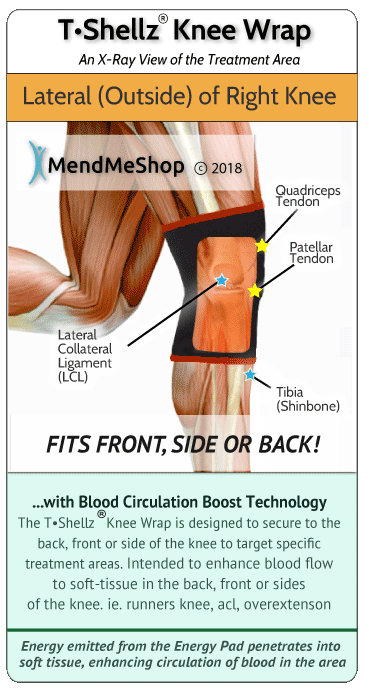 We believe the TShellz Wrap® to be one of the most effective home treatments to increase localized blood flow in and around the treatment area (which would be the knee). To get more blood flow to the area, you need to either use the knee or use a localized enhanced circulation device. Since using a damaged meniscus is out of the question, if you want to accelerate blood flow to the meniscus, you need a Knee TShellz Wrap® We can promise that you will receive a product that is designed to be safe and does what it is supposed to do... reduce pain (as stated in "Therapeutic Heat and Cold", 4th edition. - Ed. Justus F. Lehmann, M.D., Williams, and Wilkin) temporarily increase length & flexibility of soft tissue (as stated in "Therapeutic Heat and Cold", 4th edition. - Ed. Justus F. Lehmann, M.D., Williams, and Wilkin) and aid your body in recovering from tendon, muscle and other soft tissue injuries via enhanced blood flow. 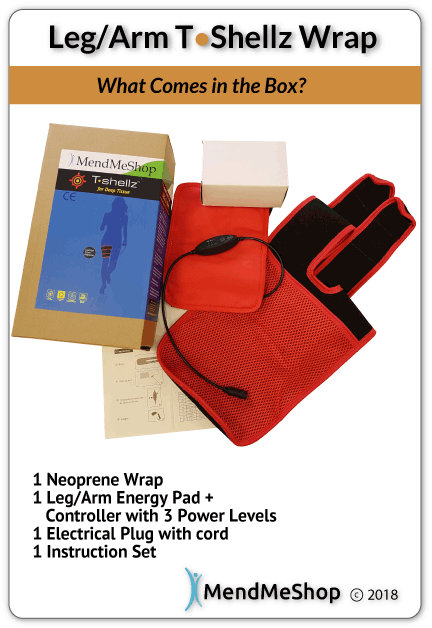 The unit plugs into a standard wall outlet to get its power. The nice thing about the power supply is that the same unit can be used in North America and overseas as well. It has the capability to operate between 110v and 230v. The TShellz Wrap® has a special signal controller that can be set for 3 different power levels of application (3=High, 2=Medium, 1=Low). The cord is long enough that you can sit or lie comfortably and watch TV, read or surf the net while you're using it. Treatments are max 30 minutes in duration and the device can be worn over clothing. This allows you to use the device at work, at home, or really anywhere you have access to an electrical outlet. We recommend 5 to 10 minute treatments to start; the safety shutoff controller is set to max 30 minutes in duration. The device can be worn over clothing and allows you to use the device at work, at home, or really anywhere you have access to an electrical outlet. A Recap of the Benefits of the Knee TShellz Wrap®..
The benefits of TShellz Wrap® do not end once your knee pain stops! Even once your meniscus troubles are mostly behind you, your activities can put your knee at risk of an overuse injury, tightness, or another tear. A TShellz Wrap® treatment before activity is an easy way to warm up the knee tissues and prepare them for use. Then, end your day with another treatment to prevent tightness from setting in overnight. This incredible healing tool will be the ticket to healthy knees for years to come! When Should I Use My TShellz Wrap® During the Day?The most common question we receive from individuals prior to purchasing is - how many times a day should I be using my wrap and when should I be using them? While treatment plans will differ for each individual and their specific injury, there are general guidelines that should be adhered to.
The TShellz Wrap® would then be used:
Use a Knee TShellz® Circulatory Boost Wrap:
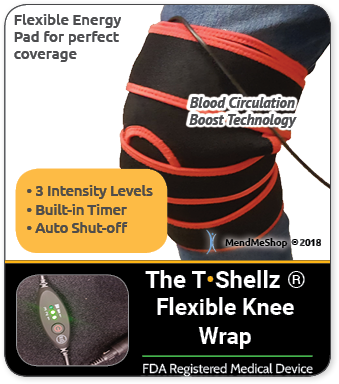 Increased Blood Flow = More Oxygen, More Nutrients and Less Toxins = Healthier TissueWe believe the use of TShellz Wraps® for boosting blood flow in the area of application is one of the most under-utilized home treatment options available on the market today. We have client after client that have tried many options out there and have been amazed at how effective and fast the TShellz Wrap treatment can relieve pain and increase localized blood flow in the treatment area. The TShellz Wraps significantly increase bloodflow to tissue in the treatment area - period. With regular use of the Knee TShellz Wrap:
Attach the TShellz Wrap® around your leg, plug it in and let the Energy Pad do the work!*Know that every personal soft tissue injury is unique and the TShellz Wrap may not work for everyone. This is why we offer a 60-day full money back return on all our TShellz Wrap devices. Stage 3 - In Between Treatments With TShellz Wrap®, Apply Our New Fast Acting Pain Relief Cream Called ARNICA INFUSIONDealing with aches and pains affecting the foot, ankle, leg, knee, hamstring, hip, back, arm, shoulder, elbow, wrist, or hand? If so, then applying the Arnica Infusion to any of these targeted areas will bring about fast relief from the pain and sore tissues. Simply apply a small amount of cream to the body and moments later, you will experience a soothing and comforting sensation over the area. Arnica Infusion is specially designed to relieve pain due to sore muscles and joints associated with arthritis, backaches, sprains, strains, and bruises. No matter if you are dealing with an acute injury, chronic pain, or a general "flare-up" - you will experience fast relief from pain and inflammation. This is a product that many of our current MendMeShop customers asked us to develop. So we focused our time and resources over the past few years and came up, with we believe, will be one of more effective, fast acting, topical pain relief creams on the market. You are likely familiar with some of the standard topical agents on the market as most of our customers use them. The are mass marketed and even found in most department stores now. Well, we are here to say that Arnica Infusion goes many steps beyond what they offer. Made in the USA at an FDA registered manufacturing facility, you can be assured that Arnica Infusion is both safe and effective. We only source top grade ingredients while implementing strict quality control checks during every step of the production process. Expect the same high quality that MendMeShop customers have been accustomed to since we started the company in 2005. The "Cool Blue" formula is the perfect balance between the smooth application of a cream and the effective absorbing factor of a gel. It is not too thick and not too thin - just the right texture. Best of all, it feels very nice on the skin! Each application of Arnica Infusion feels so comforting and soothing, we are certain it will become an item you will not want to live without. Arnica Infusion IngredientsThe Arnica Infusion formula is based on a combination of scientific research and the use of high quality ingredients. The properties within the formula were chosen for their pain relief, anti-inflammatory, and soothing qualities. The acting ingredients within the formula include ones many of us are familiar with; along with ones that have not received a lot of publicity (only in research circles). Extensive testing resulted in a blending of ingredients that provides the most synergistic of benefits. The notable ingredients in the Arnica Infusion formula include:
Extensive quality control procedures during the manufacturing process ensure the ingredients and final product are both safe and effective. We would not stake our reputation on anything but the best. When Do I Apply the Arnica Infusion?While At WorkApply Arnica Infusion at work to help reduce acute discomfort associated with overuse of muscles and joints. No matter if you are in a physical demanding job or work within an office environment, you will be placing stress on different parts of the body and aches and pains will result. Before Or After Work, Sports, & ActivityIf you suffer from a sprained ligament, pulled muscle, strained tendon, or even bruising - apply Arnica Infusion for quick relief of the pain. Chronic Pain SufferingApplication of Arnica Infusion can be done up to a maximum of 4 times per day on a consistent basis to help bring about relief from various pains and aches. In-between Treatments With the TShellz Wraps®Follow up your T-Shellz and Cold treatments with an application of Arnica Infusion. Combine the pain relieving benefits of Arnica Infusion along with the healing benefits of the wraps to make your recovery go much more smoothly. Do not apply Arnica Infusion within a 2 hour timespan before a TShellz Wrap® treatment. Whether you decide to use the Arnica Infusion in conjunction with the TShellz Wrap® and other treatments - or if you decide to use the cream as a stand-alone product - you will not be disappointed with the results. We guarantee it. Step 4: Passive Knee Stretching...
|
        |







